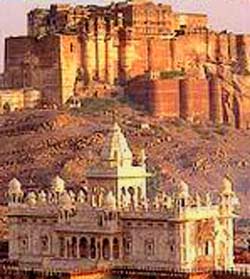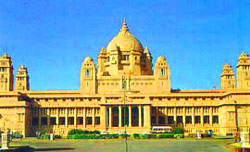|
Once the capital of the Marwar state, Jodhpur was founded in 1459 AD at the edge of the Thar desert by Rao Jodha who claimed to be a descendant of Rama - the epic hero of Ramayana. | | | |
The second largest city of Rajasthan, regal Jodhpur, echoes with tales of antiquity in the vacuum of the desert. Once the capital of the Marwar state, it was founded in 1459 AD at the edge of the Thar desert by Rao Jodha who claimed to be a descendant of Rama - the epic hero of Ramayana. The massive 15th century AD Mehrangarh Fort seems to grow out of a cliff soaring 125m above the plains. Encompassed by a high wall with 8 gates and incalculable bastions, the towers of the fort were built by Rao Maldeo in the 16th century when Jodhpur was a booming trade town. Poised on both the international east-west trading route between Central Asia and China and on the strategic Delhi-Gujarat route, the Marwari traders amassed fortunes from the passing camel caravans.
If Jaipur is the "Pink City", Jodhpur can be called the "Blue City". The traditional homes are all painted a pale indigo. The graceful palaces, forts and temples throughout the city bring alive the historic splendour of the area. Folk dances and music lend a romantic aura to the city. The locals here wear lovely multihued costumes, which are artistically designed. The women wear wide gathered skirts and a hip length jacket while the turbans worn by the men add sheer colour to the city. Jodhpur's royal contribution to the world has been, none other than "Jodhpurs" or riding breeches, as we know them today. Sir Pratap Singh, an inventive maharaja, also came up with ankle-length Jodhpur boots and the close-collared princely Jodhpuri coat.
|
More on Rajasthan
• An Overview
• Geography
• People & Culture
• Economy
• Festivals
• Wild Life
• Adventure
• Climate
Cities
• Ajmer Shareif
• Bharatpur
• Bikaner
• Chittaurgarh
• Jaipur
• Jaisalmer
• Kota
• Mount Abu
• Ranakpur
• Sariska
• Udaipur
Travelogues
• Mount Abu
Impressions
• Rajasthan
|
|
Jaipur dates back to the reign of Jai Singh II, who ascended the throne of Amber in 1699. |
|
|
|
|
Jodhpur's traditional craftsmen are found in abundance in the maze of old lanes focused on the Sardar Bazar and its Clock Tower of 1912. Their creations include lacquer coloured bangles, 'bandhani' patterns on cotton, felt goods, embroidered 'jutis' or slippers, carpets and leather water bottles. Countless festivities celebrate the rich past and culture of the princely state. The Marwar Festival held annually is one such splendid bonanza.
|
Landmarks
 Mehrangarh Fort
Mehrangarh Fort
One of the most impressive structures of Rajasthan is the Mehrangarh Fort. Seemingly growing out of the rocky cliff 125m high, on which it is perched, it has a commanding view of the surrounding landscape. In fact, one can see the Kumbhalgarh Fort, some 80 miles (130 km) away. Although invincible from the outside, the fort has four gates approached by a winding road. The overhanging jharokhas or balconies of the palace, with fine stone lattice work and the throne room Moti Mahal or Pearl Palace, with its ceiling gorgeously embellished with mirror-work and gilt - is said to have been made of nearly 80 pounds of gold. Other palaces in the complex are the Phool Mahal, Sheesh Mahal, Sileh Khana and Daulat Khana. The Fort Museum is one of the finest and best laid out in Rajasthan. There is the palanquin section followed by the howdah section, with perhaps one of the finest collections of ornate elephant howdas in the world. The armoury section has one of India's finest collection of weapons, particularly swords, including that of the Mughal Emperor Akbar himself, and Rao Jodha's enormous khanda, weighing over 7 pounds. There's also a very interesting collection of over a hundred different types of turbans from various parts of Rajasthan, miniature paintings of various schools, musical instruments, costumes and furniture.
 Jaswant Thada
Built in 1899 AD, in memory of Maharaja Jaswant Singh II, it is a cluster of graceful royal white marble cenotaphs of the rulers of Jodhpur. Within the main cenotaph are the portraits of various Jodhpur rulers.
Umaid Bhawan Palace
 This is the only 20th century palace of Rajasthan. The gigantic Umaid Bhawan Palace - a stately mansion based on the Western model has the distinction of having been one of the largest private residences of the world. Today, it houses an excellent little museum of some of the royal family's possessions and a luxury hotel and the present Maharaja's residence. A major famine in Jodhpur in the early 1920's prompted the Raja to embark on the construction of this enormous palace as one of the public works projects devised to offer employment to the people of the kingdom. It took 16 yea
Museum The museum has an exquisite ensemble of paintings, sculptures and antique weapons.
This is the only 20th century palace of Rajasthan. The gigantic Umaid Bhawan Palace - a stately mansion based on the Western model has the distinction of having been one of the largest private residences of the world. Today, it houses an excellent little museum of some of the royal family's possessions and a luxury hotel and the present Maharaja's residence. A major famine in Jodhpur in the early 1920's prompted the Raja to embark on the construction of this enormous palace as one of the public works projects devised to offer employment to the people of the kingdom. It took 16 yea
Museum The museum has an exquisite ensemble of paintings, sculptures and antique weapons.
Mandore (8 km)
The ancient capital of Marwar before Jodhpur came up; it has cenotaphs of the Jodhpur rulers. The Hall of heroes has fifteen figures carved out of the rock on the wall, which represent Hindu deities. Its beautiful gardens with high rock terraces make it a popular picnic spot. Mahamandir Temple (4 km) & Balsamand Lake & Gardens (5 km) The Mahamandir Temple with 84 carved pillars is built around a Shiva temple. The Balsamand Lake built in 1159 AD is a splendid summer palace which stands by the lakeside surrounded by beautiful gardens. Bats swoop down to the lake in the evening for a drink. An idyllic spot for excursions. Osian (58 km) An oasis in the desert, situated on the diversion off the main Jodhpur-Bikaner Highway. Once a great religious centre, its ruins today present one of the finest depictions anywhere of how Indian temple architecture evolved between the 8th and 12th centuries. The most outstanding of the 15 beautifully sculptured Jain and Brahmanical temples are the Surya or Sun Temple and the Kali temple, Sachiya Mata Temple and the main Jain temple dedicated to Lord Mahavira. Dhawa (45 km) A wildlife sanctuary with the largest number of Indian antelopes. Nagaur (135 km) The historic Ahhichatragarh fort with its beautiful murals attracts many a visitor here. It is also the venue for a week long cattle fair held in Jan/Feb every year and is visited by thousands of rural people from far and wide.Rohet Fort (40 km) and Luni Fort (20 km) Now converted into heritage hotels, both these forts are worth a visit.  AdventureSafari Jeep safari to one of the picturesque villages of the Bishnoi community. The rustic Bishnois are, traditionally, very environment conscious and animal-lovers. You can spot a herd of deer grazing fearlessly in the village farms. A large number of migratory birds also come here in the season. | General Information Accommodation Umaid Bhawan Palace offers pure luxury and palatial splendour. The Ratnada Polo Palace and the Taj Hari Mahal are other top end hotels in Jodhpur. The Devi Bhawan offers rooms and cottages and is a great place to stay. Ratan Vilas and Newtons Manor offer accommodation and home cooked meals. Ajit Bhawan with its stone cottages and Hotel Karni Bhawan are some mid range hotels. Haveli Guest
Mumbai. You can take an auto rickshaw/taxi from the airport to town, a distance of 5 km. Rail Jodhpur is well connected by train to Jaisalmer, Kota, Bikaner, Jaipur, Delhi and Ahmedabad. Road Buses linking Jodhpur to Ajmer, Udaipur, Jaipur, Jaisalmer, Delhi and Ahmedabad are available at the bus stand. Shopping Jodhpur specialises in antiques, along the road connecting Ajit Bhawan and Umaid Bhawan Palace. The usual Rajasthani handicrafts are also available here. Close to the Clock Tower is a shop specialising in an array of Indian spices. Climate : Mean Max. Mean Min. Summer: 42.2 degree C 27.3 degree C; Winter: 27.5 degree C 9.5 degree C Clothing : Summer light tropical; Winter: light woollen Best Season:: Oct. - March Languages : English, Hindi, Marwari.
 |
Editor: Romola Butalia (c) India Travelogue. All rights reserved. |
|

 Mehrangarh Fort
Mehrangarh Fort This is the only 20th century palace of Rajasthan. The gigantic Umaid Bhawan Palace - a stately mansion based on the Western model has the distinction of having been one of the largest private residences of the world. Today, it houses an excellent little museum of some of the royal family's possessions and a luxury hotel and the present Maharaja's residence. A major famine in Jodhpur in the early 1920's prompted the Raja to embark on the construction of this enormous palace as one of the public works projects devised to offer employment to the people of the kingdom. It took 16 yea
Museum The museum has an exquisite ensemble of paintings, sculptures and antique weapons.
This is the only 20th century palace of Rajasthan. The gigantic Umaid Bhawan Palace - a stately mansion based on the Western model has the distinction of having been one of the largest private residences of the world. Today, it houses an excellent little museum of some of the royal family's possessions and a luxury hotel and the present Maharaja's residence. A major famine in Jodhpur in the early 1920's prompted the Raja to embark on the construction of this enormous palace as one of the public works projects devised to offer employment to the people of the kingdom. It took 16 yea
Museum The museum has an exquisite ensemble of paintings, sculptures and antique weapons.